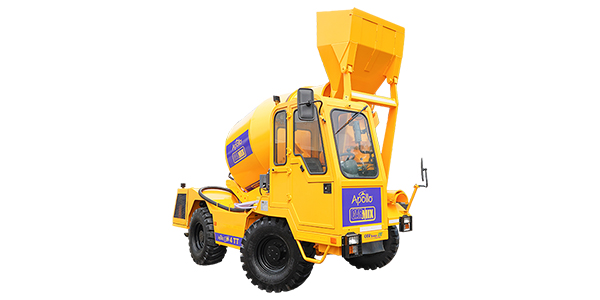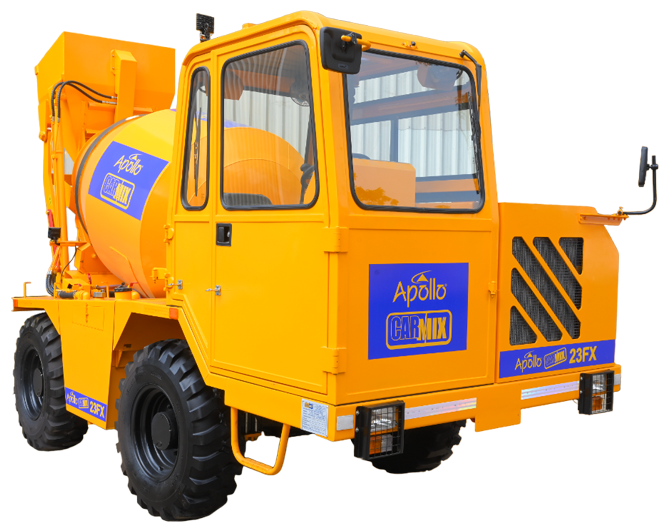
Self-loading concrete mixers have revolutionized the way concrete is produced and delivered on construction sites. Combining the functions of a concrete mixer and a loader, these versatile machines provide numerous advantages that enhance productivity, reduce costs, and improve the overall efficiency of construction projects. Here, we explore the top benefits of using self-loading concrete mixers on construction sites.
- Enhanced Productivity and Efficiency
One of the most significant benefits of self-loading concrete mixers is their ability to enhance productivity and efficiency. These machines automate the loading, mixing, and transportation of concrete, which traditionally required multiple pieces of equipment and significant manual labor. By combining these processes into one seamless operation, self-loading mixers significantly reduce the time and effort needed to produce and deliver concrete.
Key Features Enhancing Productivity:
- Automatic Loading: The hydraulic shovel automatically loads the aggregates and cement into the mixing drum, eliminating the need for manual loading.
- Continuous Mixing: The mixing drum continuously rotates, ensuring a consistent and homogeneous mix of concrete.
- Mobility: Mounted on wheels, these mixers can easily move around the construction site, delivering concrete directly to where it’s needed.
- Cost Savings
Cost efficiency is another major advantage of self-loading concrete mixers. By consolidating multiple functions into a single machine, construction companies can save on equipment, labor, and transportation costs.
Cost-Saving Aspects:
- Reduced Labor Costs: With self-loading mixers, fewer workers are needed to operate and manage the concrete mixing process.
- Lower Equipment Costs: The need for additional loaders, mixers, and transport trucks is eliminated, reducing the overall investment in machinery.
- Fuel Efficiency: Modern self-loading mixers are designed to be fuel-efficient, further reducing operational costs.
- Improved Concrete Quality
Self-loading concrete mixers are equipped with advanced features that ensure the production of high-quality concrete. Consistent and precise mixing is crucial for the strength and durability of concrete structures.
Quality-Enhancing Features:
- Electronic Weighing System: This system ensures the accurate measurement of materials, resulting in a consistent mix ratio.
- Hydraulic Controls: The hydraulic system provides precise control over the mixing process, ensuring a uniform mix.
- High-Pressure Washing System: This feature allows for thorough cleaning of the mixing drum, preventing contamination of subsequent batches.
- Flexibility and Versatility
Self-loading concrete mixers offer unmatched flexibility and versatility, making them suitable for a wide range of construction projects. Whether it’s a small-scale residential project or a large infrastructure development, these mixers can handle various tasks efficiently.
Versatile Applications:
- Remote and Hard-to-Reach Sites: Their mobility makes them ideal for projects in remote or difficult-to-access locations.
- Variety of Concrete Types: They can produce different types of concrete mixes, including standard concrete, high-strength concrete, and specialized mixes for specific applications.
- All Weather Conditions: Self-loading mixers are built to operate in various weather conditions, ensuring continuous work progress.
- Time Savings
Time is a critical factor in construction projects, and delays can lead to increased costs and missed deadlines. Self-loading concrete mixers help save time in several ways:
Time-Saving Features:
- On-Site Mixing: Concrete can be mixed directly at the construction site, eliminating the need to transport it from a central mixing plant.
- Quick Setup: These machines are designed for quick setup and can start producing concrete within minutes.
- Continuous Operation: With the ability to produce concrete continuously, construction teams can maintain a steady workflow without interruptions.
- Environmental Benefits
Environmental considerations are becoming increasingly important in the construction industry. Self-loading concrete mixers contribute to sustainability in several ways:
Eco-Friendly Aspects:
- Reduced Waste: Precise measurement and mixing reduce material waste, contributing to more sustainable construction practices.
- Lower Emissions: Modern self-loading mixers are designed to be fuel-efficient and emit fewer pollutants, reducing the environmental impact.
- Resource Efficiency: By consolidating multiple functions into one machine, these mixers reduce the overall resource consumption on a construction site.

- Enhanced Safety
Safety is a paramount concern on construction sites. Self-loading concrete mixers are designed with several safety features to protect workers and ensure safe operation.
Safety Features:
- Enclosed Cabin: The operator’s cabin is enclosed, providing protection from dust, debris, and other hazards.
- Ergonomic Design: Controls are designed to be user-friendly, reducing operator fatigue and the risk of accidents.
- Automatic Systems: Automation reduces the need for manual intervention, minimizing the risk of human error and related accidents.
- Long-Term Investment
Investing in self-loading concrete mixers can provide long-term financial benefits. These machines are built to be durable and require minimal maintenance, ensuring a long service life.
Long-Term Benefits:
- Durability: High-quality construction materials and components ensure that self-loading mixers can withstand the rigors of daily use.
- Low Maintenance: Regular maintenance is straightforward, and many parts are designed for easy replacement, reducing downtime and repair costs.
- Resale Value: Due to their durability and efficiency, self-loading mixers often have a high resale value, providing a good return on investment.
FAQs on Self-Loading Concrete Mixers
A1: Self-loading concrete mixers come in various capacities, typically ranging from 1.0 to 4.5 cubic meters per batch, depending on the model and manufacturer.
A2: Unlike traditional mixers, self-loading concrete mixers combine the functions of loading, mixing, and transporting concrete into one machine, enhancing efficiency and reducing labor costs.
A3: Yes, they are suitable for a wide range of projects, from small residential builds to large infrastructure developments, due to their versatility and efficiency.
A4: Regular maintenance includes routine inspections, lubrication of moving parts, and timely replacement of worn components. Proper maintenance ensures optimal performance and longevity.
A5: These mixers reduce material waste through precise mixing, lower emissions due to fuel efficiency, and decrease overall resource consumption by consolidating multiple functions into one machine.
A6: Safety features include enclosed operator cabins, ergonomic controls, automatic systems to reduce manual intervention, and robust construction to protect against job site hazards.
Conclusion
Self-loading concrete mixers offer a multitude of benefits that make them an invaluable asset on construction sites. Their ability to enhance productivity, reduce costs, improve concrete quality, and provide flexibility makes them a preferred choice for many construction projects. Additionally, their environmental benefits, enhanced safety features, and long-term investment potential further solidify their value in the construction industry. By adopting self-loading concrete mixers, construction companies can streamline their operations, achieve better results, and maintain a competitive edge in the market.
Recent Articles
- Market Growth and Future Trends in Self-Loading Concrete Mixers for the Construction Industry
- How Self-Loading Concrete Mixers Reduce Labour Costs and Increase Productivity?
- Comparing Self-Loading Concrete Mixers vs. Traditional Concrete Mixing Methods
- The Role of Self-Loading Concrete Mixers in Modern Construction
- Self-Loading Concrete Mixer Machines for Infrastructure Development Projects
Copyright © 2025, Apollo Carmix Equipments Private Limited (ACEPL), All rights are reserved.
Web Design & SEO by Webmasterindia

